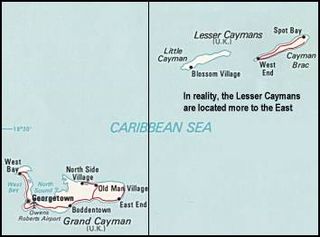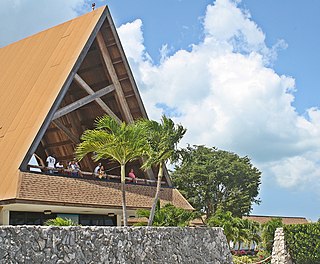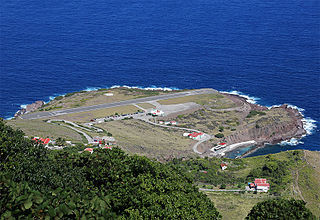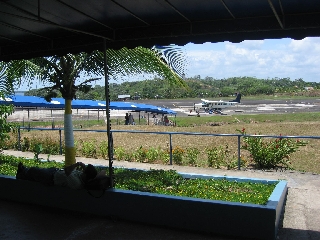
The Cayman Islands are a British overseas territory located in the Caribbean that have been under various governments since their discovery by Europeans. Christopher Columbus sighted the Cayman Islands on May 10, 1503 and named them Las Tortugas after the numerous sea turtles seen swimming in the surrounding waters. Columbus had found the two smaller sister islands and it was these two islands that he named "Las Tortugas".

The transport infrastructure of the Cayman Islands consists of a public road network, two seaports, and three airports.

Owen Roberts International Airport is an airport serving Grand Cayman, Cayman Islands. It is the main international airport for the Cayman Islands as well as the main base for Cayman Airways. The airport is named after British Royal Air Force (RAF) Wing Commander Owen Roberts, a pioneer of commercial aviation in the country, and is one of the two entrance ports to the Cayman Islands.

Grand Cayman is the largest of the three Cayman Islands and the location of the territory's capital, George Town. In relation to the other two Cayman Islands, it is approximately 75 miles (121 km) southwest of Little Cayman and 90 miles (145 km) southwest of Cayman Brac.
Cayman Airways is the flag carrier airline of the British Overseas Territory of the Cayman Islands. With its head office in Grand Cayman, it operates mainly as an international and domestic scheduled passenger carrier, with cargo services available on most routes. Its operations are based at Owen Roberts International Airport in George Town, Grand Cayman. The company slogan is Those who fly us love us.
Avianca Costa Rica S.A., formerly known as LACSA, minority owned by the Synergy Group, is the national airline of Costa Rica and is based in San José. It operates international scheduled services to over 35 destinations in Central, North and South America. The airline previously used the TACA/LACSA moniker when it was a subsidiary of Grupo TACA. Since May 2013, following Avianca's purchase of Grupo TACA, Avianca Costa Rica became one of seven nationally branded airlines operated by Avianca Group of Latin American airlines.

Little Cayman is one of three Islands that make up the Cayman Islands. It is located in the Caribbean Sea, approximately 60 miles (96 km) northeast of East End, Grand Cayman and five miles (8 km) west of West End, Cayman Brac. Little Cayman is the least populous island of the three, with a permanent population of about 160 (2021) including seasonal residents/homeowners. The majority of the population are expatriate workers from Jamaica, the Philippines, and Honduras and from other Latin American countries as well as Canada, the USA, India, Australia, Scotland, England, and South Africa. There are a handful of local Caymanians estimated as fewer than 20. It is about 10 miles (16 km) long with an average width of 1 mile (1600 m) and most of the island is undeveloped. Almost the entire island is at sea level. The highest elevation is about 40 feet. The rainy season, which consists of mostly light showers, occurs in Mid-April until June and again in mid-September to mid-October. There will be occasional quick rain showers in the early morning hours. The coolest months are from End of November until Mid March as the cold fronts coming in from the North which the temperature can drop into the low'70s. The Hottest and dryest months are in Summer starting mid-June to mid-September with temperatures between the mid-80s and high 90s. There are no large or predatory or poisonous animals or creatures if you decide to go exploring. There are some non-fatal poisonous plants for which contact can result in an itchy rash.

Cayman Brac is an island that is part of the Cayman Islands. It lies in the Caribbean Sea about 145 km (90 mi) north-east of Grand Cayman and 8 km (5.0 mi) east of Little Cayman. It is about 19 km (12 mi) long, with an average width of 2 km (1.2 mi). Its terrain is the most prominent of the three Cayman Islands due to "The Bluff", a limestone outcrop that rises steadily along the length of the island up to 43 m (141 ft) above sea level at the eastern end. The island is named after this prominent feature, as "brac" is a Gaelic name for a bluff.

Juancho E. Irausquin Airport is an airport on the Dutch Caribbean island of Saba. Its runway is widely acknowledged as the shortest commercial runway in the world, with a length of 400 m (1,312 ft).

Golosón International Airport is an airport located on the western side of the city of La Ceiba, in the Atlántida Department on the north coast of Honduras. It is also known as La Ceiba Airport and Hector C. Moncada Air Base.

Sir Captain Charles Kirkconnell International Airport is an airport serving Cayman Brac, Cayman Islands. It is one of the hubs for Cayman Airways with flights to Owen Roberts International Airport on Grand Cayman, and Edward Bodden Airfield on Little Cayman. It is the only airport on Cayman Brac.

Bonriki International Airport is an international airport in Kiribati, serving as the main gateway to the country. It is located in its capital, South Tarawa, which is a group of islets in the atoll of Tarawa in the Gilbert Islands, precisely on Bonriki.

Kaikoura Airport is an uncontrolled aerodrome located 4 nautical miles southwest of Kaikoura at Peketa in the South Island of New Zealand.

Bluefields International Airport is an airport serving Bluefields, a harbor city in the South Caribbean Coast Autonomous Region of Nicaragua. It is the busiest airport in the Caribbean coast of Nicaragua.

Chios Island National Airport is an airport on the island of Chios in Greece. It is also known as Chios National Airport, "Omiros" or Chios Airport located at the region of Kampos, south of the city of Chios. Aircraft up to the size of Airbus A320 are able to land at the airport.
A STOLport or STOLPORT was an airport designed with STOL operations in mind, usually for an aircraft class of certain weight and size. The term "STOLport" did not appear to be in common usage as of 2008, although was commonly used by pilots flying into Biggin Hill during 1986/87 when the London City Airport was opened restricting approaches and ceilings to the north of Biggin. A STOLport usually has a short single runway, generally shorter than 1,500 m (5,000 ft). STOLports are only practicable by certain types of aircraft, especially smaller propeller aircraft, with performances that are compatible with the shorter runway length, steeper approach/departure paths, etc. at individual STOLports. In the United States, short runway facilities are simply known as airports, and the term "STOLport" has not been commonly used since the early 1970s.

Anatom Airport, also known as Aneityum Airport, is an airfield serving the island of Aneityum, in the Taféa province in Vanuatu. The airfield is actually located on the smaller Inyeug island.

Mustique Airport is a private airfield owned by the Mustique Company for public use and is located on Mustique island, part of Saint Vincent and the Grenadines in the Caribbean Sea. It is used by civil aviation and national airlines using turboprop planes.

Pontoise Aerodrome or Pontoise – Cormeilles Aerodrome is an airport located 7 km (3.8 NM) northwest of Pontoise in Boissy l'Aillerie near Cormeilles-en-Vexin, all communes of the Val-d'Oise department in the Île-de-France region in northern France. The airport is also located 16 miles (26 km) northwest of Paris.


















